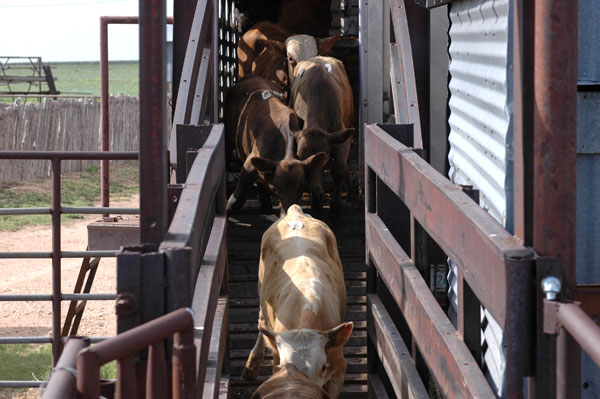What's the best marketing option this cattle cycle?
What's the best way to market your calves for the current cattle cycle? A look at historical data points to selling backgrounded feeders.
September 23, 2019

My study rancher asked that I assemble a historical marketing analysis of his herd over the last cattle cycle from 2009 through 2018. This analysis is the subject of this month’s article: Marketing alternatives for the current cattle cycle.
I generated a 10-year marketing analysis covering the current cattle cycle for my study herd manager. This study analyzed four marketing alternatives:
sell weaned calves
sell backgrounded feeders weighing 800 pounds
finish the background calves in a commercial feedlot
grow and finish each year’s calves in a commercial feedlot
Figure 1 presents the summary data generated for these four marketing alternatives. Each marketing alternative is expressed on a per-cow basis. Farm-raised feeds were charged into each marketing alternative at market value and not at the cost of production. Pasture costs are based on the going rental rate for the study rancher’s area.

I then elected to add two more columns on the right-hand side of Figure 1. The next-to-last column summarizes the average profit projected for a cow that weaned a calf, and that calf was backgrounded on the ranch. The profits from weaning and backgrounding are added together.
The right-most, final column represents a cow that weaned a calf, and that weaned calf was entered into a retained ownership program via a commercial feedlot. These two profits, “Sell at weaning” and “Retain calves,” were also added together.
Interpreting Figure 1. Figure 1’s bottom five lines summarize these marketing alternatives for this herd over the current cattle cycle – 2009-18. The bottom five-line summary does not include the data for 2007 and 2008, as those years were in the previous cattle cycle.
Selling at weaning. The sell-at-weaning average net income per cow varied from a -$15 in 2009 to a high of $808 per cow in 2014, then back down to $128 per cow in 2018. You can clearly see the impact of the beef price cycle.
Net income from the cow herd is the earned net return to unpaid labor, management and equity capital. The 10-year average net income per cow was $189 per cow per year. The 10-year total net income totaled $1,904 per cow. Only one year in the current cattle cycle was the net income per cow negative.
Standard deviation is a statistical measure of the year-to-year variation. The higher the standard deviation, the more variable the annual net incomes. A low standard deviation is desired.
The standard deviation for selling at weaning is 220 — the second-highest of all marketing alternatives, implying a large variability of annual net incomes.
Backgrounding the calves. Backgrounding the calves, presented in the second column, bounced around from year to year, with a 10-year average of only $15 per calf. The highest profit years were in 2010 and 2016. The worst years were in 2015, 2017 and 2018 — three different years after the 2014 peak price year. The 10-year accumulated total was $51 per head. Five out of the 10 years, the numbers were negative.
Finishing backgrounded calves in a commercial feedlot. In this marketing alternative, ranch-backgrounded calves were assumed sent to a commercial lot to be finished and marketed. The 10-year average was minus $42 per head, based on cash-to-cash marketing (no hedging or price protection). The standard deviation was 128, about the same as for backgrounding.
The returns in the loss years exceeded the positive years, so the 10-year accumulated total was minus $372. Not good.
Five out the 10 years, the earned net returns were negative.
Retain ownership of calves grown and finished in a commercial feedlot. Moving the calves immediately from weaning to a commercial feedlot was somewhat more favorable. Again, a cash-to-cash marketing program was assumed — no price protection taken.
In this marketing option, the feeders were weaned early and pushed hard, with a target marketing date of May each year — not an easy target to hit.
The 10-year average was $63 per head, with a standard deviation of 148 — the higher of the two postweaning marketing alternatives.
The positive years in the retained ownership marketing program out-valued the negative years, so the 10-year total was $476 per beef cow. Three years out of the 10 years were negative.
Selling backgrounded feeders. The “Sell bckg. feeders” column represents the combined value of selling at weaning plus the value added, if all the calves were also backgrounded on the ranch. The calves were priced when weaned, and that selling price became the purchase price for the feeders going into the backgrounding enterprise.
Selling backgrounded feeders averaged a $204 profit per head over the 10 years and generated some more potential profits, compared to selling at weaning. But, the standard deviation for selling backgrounded feeders was greater at 241, implying more year-to-year variation.
An interesting fact: 97% the profit earned over the total cattle cycle came from the cow herd when marketing backgrounded feeders. This leaves only 3% of the total profits over the cattle cycle being generated from the backgrounding enterprise.
Note: all 10 years in selling backgrounded feeders were positive!
The total 10-year net income from selling backgrounded calves was also slightly higher than selling every year at weaning. Obviously, some of the low profit years when selling at weaning were offset by higher profit years backgrounding. I suspect this is the primary reason that ranchers background their calves.
Might I suggest that another benefit from background calves is the reduced year-to-year income variability? This might be the most significant finding in this study.
Retained ownership of calves. Retained ownership, the right-most column in Figure 1, combined with running the beef cows, appears to be the most favorable marketing program over the complete cycle.
The calculated 10-year combined net income from the beef cow herd and retained calf enterprise is $2,380 — the highest of all the marketing alternatives. The 10-year average was $252 per cow. The standard deviation is lower, at 154, suggesting a lower year-to-year variation.
Eighty percent of that net income from retained ownership was generated by the beef cow herd up through weaning; and 20% of the net income, over the cattle cycle, was added by retained ownership.
My next Market Adviser will look at breaking down the marketing decision over a complete cattle cycle into “marketing during the expansion phase” and “marketing during the contraction phase.” Stay tuned.
Hughes is a North Dakota State University professor emeritus. He lives in Kuna, Idaho. Reach him at 701-238-9607 or [email protected].
About the Author(s)
You May Also Like




.png?width=300&auto=webp&quality=80&disable=upscale)
